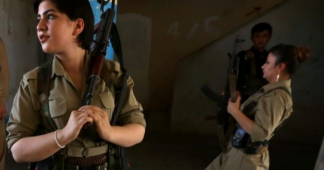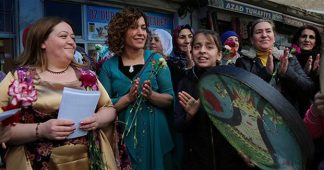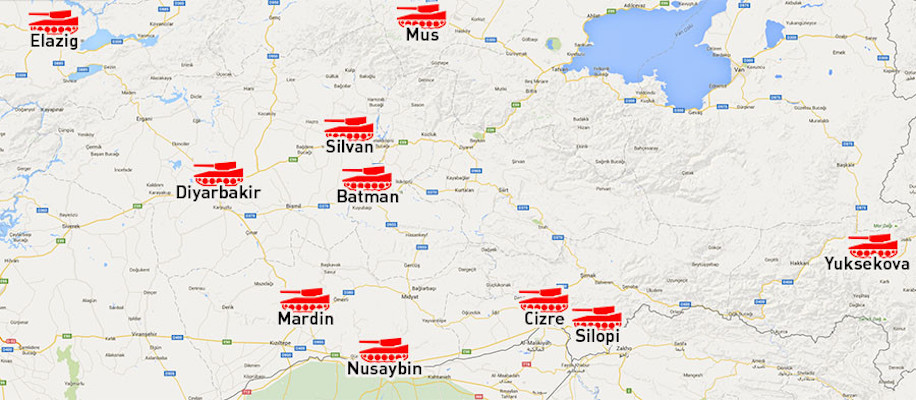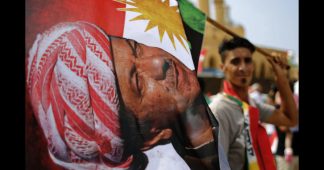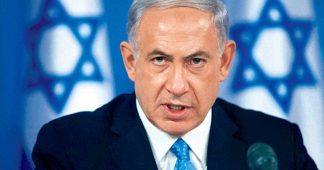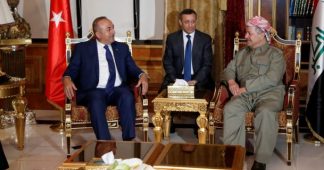By Leandro Albani / Source: Marcha.org / The Dawn / November 13, 2015-. In the 1940s, the Kurdish people lead an unique experience: the creation of the Republic of Mahabad.
Mountains, valleys and rivers that come down on the arid and rugged land witnessed, in the cold winter of 1946, the birth of a Republic that lasted only a year. In North Western area of Iran —historically a province of Kurdistan— after rebellions and acts of disobedience, a group of tribal leaders shaped the Republic of Mahabad, in which the Kurds reached two of their many aspirations: freedom and independence.
The place for the proclamation of the Republic was Chwar Chira, the central square of the City of Mahabad. On January 22, 1946, the flags flew announcing the new Republic. Men and women mingled with banners that had three horizontal bars, of colours red, white and green. In the center of the flags, the sun and the mountains were embraced by spikes of wheat, symbol of a people of deep rural roots.
A dream was born
The Republic of Mahabad was founded in the context of World War II, when Soviet and British troops entered Iran to neutralize the support that the Pahlavi Dynasty offered to Nazism. The power vacuum created by the arrival of foreign forces allowed the expression of the Kurdish people’s nationalist feelings for independence.
A year after claiming for independence for the Kurds before the UN in 1945, the leader Qazi Muhammad proclaimed the Republic. With the support of the Soviet Union, the Kurds took control of 15 thousand square kilometers, initiating a dream that lasted only 11 months.
The birth of this Republic was not accidental, because since 1941, a general uprising of the Kurdish people in Iran, ruled by Shah Reza Pahlevi with an iron fist, had been simmering. That same year a committee of leaders was formed and provided support to the Kurdish tribal chiefs, who were appointed to govern locally. In turn, the party Society for the Reconstruction of Kurdistan was founded and Muhammad (head of a family of religious jurists) was its main founding rock.

Although, at first, the Soviet Union supported the Kurdish nationalists of Iran, as time went by, disagreements started to create an uncomfortable situation: the new Republic refused to let the region be annexed to Soviet Azerbaijan and the Kremlin rejected Mahabad’s declaration of independence.
In the book “The Kurds. History of a resistance”, journalist Manuel Martorell recalls that, during the life of the Republic, in the region “a period of economic progress occurs; the lands of the collaborators with the dictatorship of the shah are given to farmers; trade with the Soviet Union is developed; women take part in the public and political life for the first time; the Kurdish language is official and is used in schools and in the administration”, in addition, various newspapers are published, such as “Kurdistan” and “Halala” (the tulip), along with the children’s magazine “Grugali Mindalan“, and a strong impetus is given to performing arts.
The decline
On March 1946, Moscow promised Iran to withdraw the Red Army from the area after constant pressures from the United States. In May of that same year, Soviet troops began to withdraw. Months later, the Pahlavi Dynasty and the Kremlin signed an agreement on oil concessions, which allowed the USSR to exploit oil in northern Iran.
Without missing a beat, the Shah military forces swooped on Mahabad to cut the roots of the new Republic. Armed attacks, cut communications and indiscriminate killings, in addition to the cancellation of Soviet aid, ended, in December 1946, with the utopia of the Kurdistan territorial nation for their original inhabitants. Qazi Muhammad, the leader of the Republic, was urged by his ministers to leave the city. His answer was that he would stay to protect the population.
Mustafa Barzani (1902-1979), who served as Defense Minister in Mahabad, lead a guerrilla resistance in the region, organizing militias and fighting the armies that did not accept a State for the Kurds. But, sadly, Mahabad was already lost.

After several defeats, in 1947, Barzani and 500 militants took refuge in the USSR. Influenced by Arab nationalism and backed by Moscow, Barzani returned to Iraq in 1958 and in 1961 led a rebellion against the central government. The Kurdistan Democratic Party (KDP) was his creation and he was accused of all kinds of low acts, among them, of having received support from Israel to create a Kurdish State that served the interests of Tel Aviv.
Mustafa Barzani ended his days in the United States, where he was received after the war between Iraq and Iran. His son, Masoud, is the current billionaire President of the autonomous Kurdistan Region, in federal Iraq.
Chra Chwar Square, which a year earlier was a reference point of the liberation struggle, became a gallows. And there, President Qazi Mohammed was hanged on the March 30, 1947, along with two other leaders of the Republic. For a whole day, the bodies were hanging in the square as a public warning.
Despite the loss of Mahabad, the Kurdish people has never surrendered. This experience was followed by acts of resistance, the creation of insurgent movements of different types, and a liberation struggle that is still being written.

